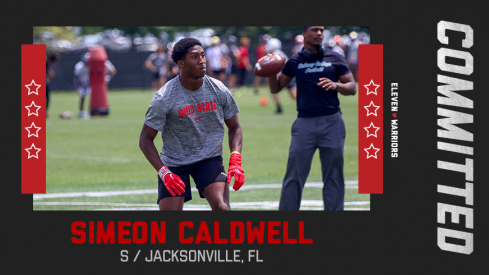Ohio State adds another top-100 safety as Simeon Caldwell commits to the Buckeyes.
In most states, 6 a.m. is reserved for rooster crows. But increasingly, dawn represents the start of spring football practice for high schools.
From Alabama to Florida, Vermont to Connecticut, it’s not uncommon to see footballs flying and hear helmets crackling under a morning sun. Nearly 20 states have implemented spring practices with days that include full pads.
Urban Meyer would like Ohio to be somewhere in the middle.
“Our [coaches] are so limited to what they’re allowed to do," Meyer said last week at the Pro Football Hall of Fame Luncheon Club in Canton. “A high school coach in Ohio is allowed to work with only four guys at a time. Think about that. You go down to Texas and there’s 85 guys out there working back and forth.”
Under the Ohio High School Athletic Association’s current rule, which came into effect in 2013, coaches in all sports can instruct as many as four athletes in out-of-season sessions. Football coaches have a 10-day period in June and July when they can conduct camps, clinics and seven-on-seven scrimmages.
Spring football in the South borders on religion. It’s an annual pigskin rebirth that creates excitement in a region where the sport is an obsession. For college coaches, it offers a chance to assess recruits, even freshmen, in a game-like environment.
Meyer enjoyed the luxury of making a state tour during his six seasons as head coach at Florida. The Sunshine State is already a hotbed for Division I talent. Additional practices give players more exposure to coaches during the April 15-to-May 31 evaluation period, thus more opportunities to secure a coveted scholarship.
At Ohio State, Meyer isn’t able to traverse the state in his SUV and watch a quarterback or defensive line prospect. Instead, he’s relegated to watching game film from the previous season.
“You’re going to come to Ohio to get great players,” Meyer said in February. “There’s the best-coached players in America in the state of Ohio. It’s old-fashioned football, old-fashioned coaching. And the one thing I love about the players in the state of Ohio, the respect factor is greater than any state in the country. The high school coach is still in charge of the program. When you go meet with a player in Ohio, you’re going to meet with his high school coach. You can’t say that about all the states across the country. That’s my favorite part about recruiting the state of Ohio.”
But...
“It’s much easier to evaluate in the South because you can watch them practice,” Meyer added. “Here, you go sit in the weight room and maybe watch them or they do some skill work. It’s almost another year of football if you look at it.”
Coaches in Florida have 20 practices, Texas has 18 in a 30-day period, even Vermont has five days of spring practice. Its northeastern neighbor, Connecticut, gives high school coaches the option of conducting 10 days of practice toward the end of the school year or adding four days to the start of practice in August.
“If there’s any way to get 10 days of spring football in the state of Ohio, then I’m here to help you,” Meyer said at the Ohio high school coaches convention in 2012. “If we can just get that done, because right now, other states are getting a little bit advanced because they get those 10 days.”
Meyer has since softened his stance, saying he’s supportive of having more coaching instruction and teaching opportunities at the conclusion of the spring sports season. He also raised questions about player safety in regards to full-padded spring practices.
But the issue isn’t going away. When Meyer speaks, it is news. Ohio high school coaches and the OHSAA have taken notice.
“Commissioner [Dan] Ross and the OHSAA staff discuss spring football practice from time to time because there are some coaches who would like to have some form of it in Ohio,” OHSAA spokesman Tim Stried said in a statement to Eleven Warriors. “However, there are many schools and high school football coaches in Ohio who do not want spring football practice for various reasons, such as they also coach a spring sport, they need a break from practice in the spring, and they won’t receive any additional compensation to conduct spring practice.
“The OHSAA has not supported spring football practice proposals, first and foremost, to protect participation in the sanctioned spring sports. Many of our member schools have told us that they would struggle to field baseball, track or boys tennis teams in the spring if some of their student-athletes didn’t play a spring sport to prepare for spring football practice. Furthermore, this would also set a precedent that other sports would also seek, such as spring volleyball practice or fall baseball practice.”
There’s no consensus from athletic directors and coaches across the state on what to do. Some want wholesale changes that include full-padded practices, others want time with an unlimited number of players and there’s even a group in favor of making no modifications to the current rules. Among the biggest opponents of spring football are coaches and administrators from small schools.
“We have a lot of kids that play spring sports, and spring football is going to discourage that. We don’t have enough kids,” said St. Henry athletic director and assistant football coach Dennis Wendel, who was a captain at Bowling Green under Meyer.
“If everyone starts to specialize, it will greatly hurt our programs. Next thing will be fall baseball and some kids would choose to do that instead of play football. In the end, all our programs will suffer. Big schools may have a different perspective.”
Not exactly. At least not Hilliard Davidson head coach Brian White, who’s led the Wildcats to two Division I state championships. He said he doesn’t have strong opinions on either side of the aisle, but noted the current structure isn’t filled with pitfalls.
Even at a school with nearly 2,000 students, White pointed out a host of issues, from adverse effects on athletes playing multiple sports to grass fields being torn up. He already believes too much is being asked of kids. They’re required to focus on sports all year and lose track of being a kid.
“I’m sure there are benefits, but I’m not sure the benefits outweigh the cost. That’s where I like making decisions, on cost-benefit ratio,” White said. “You look at a state like Kentucky, they have spring football. I wouldn’t exactly say Kentucky’s pumping out a lot of superior football players. Indiana’s coaches have more opportunities to coach kids than we do. I wouldn’t say Indiana is pumping out more than athletes than Ohio is.”
White isn’t in a position where he has to compete with southern schools. His focus is on beating teams in the Ohio Capital Conference and the playoffs. If everyone is competing by the same rules, he’s content with whatever the language states.
But anytime competitive advantages are at stake, there’s the risk of abuse.
“Spring ball will create more teams breaking more rules,” White said. “Unfortunately, there are some coaches out there that don’t have a lot of integrity and aren’t going to police themselves.”
At St. Henry, where enrollment tops out at 300 and the football team has 50 players, the idea of spring practice is a nonstarter. Members of the team do workouts and lift weights during spring months, but fewer than 20 participate because of involvement in baseball and track and field.
The Redskins have a rich athletic tradition, capturing six state football championships, four basketball championships and three baseball titles. Many of those teams had the same nucleus of players.
Where southern states such as Florida hold an advantage over Ohio is weather. In Florida, spring sports begin and end earlier in the school year, allowing more access to football.
“We do a number of things,” St. Thomas Aquinas (Fort Lauderdale) head coach Rocco Cassullo said. “That first week you want to find out what guys from the JV level can do what. So you have a lot of position battles going on and you’re laying the foundation in your schemes. We get after it pretty hard. It’s nothing but beneficial to us.”
The 20 practices end with a spring game that’s attended by over 100 FBS, FCS and Division II coaches. Casullo was a two-sport athlete and encourages his players to participate in a spring sport. When the season ends, they join the football team.
“They have no problem. Coaches like to see kids play other sports,” Cassullo said.
When Joey Bosa roared onto the scene for the Buckeyes last season, many observers were surprised, even Meyer. It’s not common for a defensive end to make an instant impact in major college football. Bosa finished the season with 44 tackles, 13.5 tackles for loss, 7.5 sacks and a fumble recovery for a touchdown.
A spectator in South Florida was not shocked at the onslaught: Cassullo. He’s seen his former players star as freshmen in the past. Aquinas is one of the top producers of Division I talent in the nation and has won two national titles and seven state championships since 1992.
“When they go to college as freshmen, they know what to expect with conditioning and summer workouts,” Cassullo said. “From a competition level, they’re just as good or even more advanced than most freshmen. We’re like a college program. I think that’s why you see a lot of St. Thomas alums playing on Saturdays.”
It all starts during the spring in Fort Lauderdale. College coaches are able to catch a glimpse of freshmen and sophomores who could blossom into blue-chippers. Bosa’s brother, Nick, began garnering attention from college programs as a sophomore. Ohio State is among his suitors and many recruiting experts believe he’s more advanced than Joey.
“From a college perspective, I understand where it’s a disadvantage to the Big Ten or the MAC,” Wendel said. “They’re missing out on 60 practices in the course of a kid’s high school career that kids in the South get.”
But does it matter? Ohio continues to be a top-five producer of Division I football players. The state provides high-end talent for much of the Midwest and the NFL. The U.S. Army All-American Bowl and Under Armour All-American game – high school football’s premier all-star games – feature Ohioans every year.
And the state’s flagship university is stockpiled with local products.
“I think things are going pretty well in the state of Ohio,” White said. “I read statistics every year about the number of athletes signing Division I scholarships out of the state of Ohio and it seems like it’s up there with everyone else. They’re behind California, Florida, Texas [and Georgia]. But they’re ahead of [45] other states. It seems like we’re doing something pretty well. I don’t know that that needs to change, to be honest with you.
“Change isn’t always better.”


